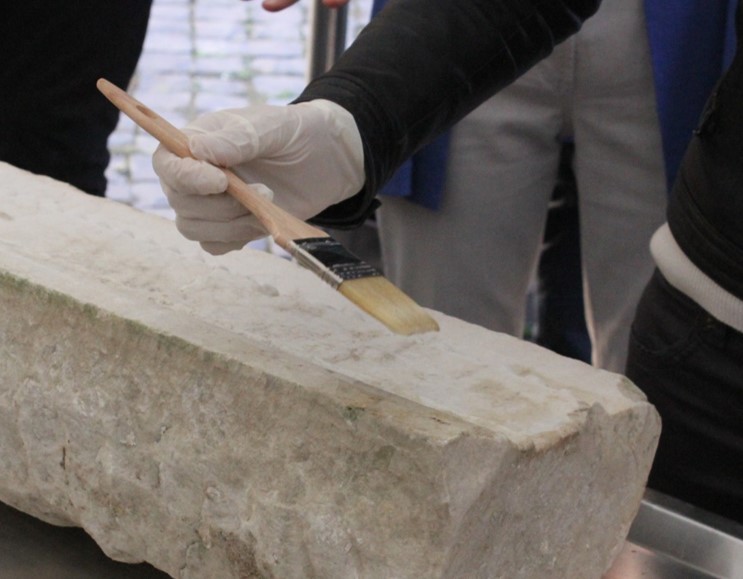Since ‘80s, the scientific research has been devoted to the development of nanomaterials to be applied in a wide range of fields, including the conservation of Architectural Heritage.
Compared to traditional materials and methods, the innovative nanomaterials show enhanced effectiveness in their main properties as their higher surface area make them more reactive.
WHAT NANOMATERIALS FOR CONSOLIDATION?
Regarding the class of stone consolidants, one of the first synthesized nanomaterial is nanolime, that is a water or alcoholic dispersion of Ca(OH)2 nanoparticles. Nanolime has been used for the consolidation of calcareous stone and wall paintings, since it presents different advantages compared to traditional limewater:
- Higher reactivity
- Deeper penetration in the substrate
- Reduction of carbonation
- Higher stability
(Chelazzi et al. 2013, Rodriguez-Navarro et al. 2013).
Different commercial nanolime and dispersions of nano-SiO2 are available on the market and their use is becoming more common among restorers, despite nowadays the most used consolidants are alkoxy-silane and oligomers. In order to overcome the drawback of alkoxy-silanes related to the formation of cracks of the silica gel, particle-modified consolidants, based on the introduction of different nanoparticles in pre-polymerized tetraethoxysilane, have been proposed (Miliani et al. 2007, Kim et al. 2009).
Another interesting nano-consolidant is the one proposed by Verganelaki, which consists in the incorporation of nanoparticles of amorphous calcium oxalate monohydrate in TEOS to form a crack-free nanocomposite, with a good penetration depth inside the substrate, able to increase the strengthening properties of decayed calcareous building stones and cement mortars (Verganelaki et al. 2015).
WHAT NANOMATERIALS FOR PROTECTION?
 Nanotechnology is also applied for the synthesis of protective treatments for stone materials, realized by adding different nanoparticles (SiO2, SnO2, Al2O3) inside polymeric media (poly(methyl methacrylate), functionalized perfluorinated polyether and polyalkylsiloxane) to increase the stone surface roughness (Manoudis et al. 2009, Facio and Mosquera 2013). These nanocomposites are able to confer super-hydrophobic (water contact angle > 150°) and self-cleaning properties to the stone. Moreover, TiO2 nanoparticles have been used for the synthesis of self-cleaning consolidants and protective treatments because of their photocatalytic property to promote the degradation of inorganic and organic pollutants and their ability to create superhydrophilic surfaces (Munafò et al. 2015).
Nanotechnology is also applied for the synthesis of protective treatments for stone materials, realized by adding different nanoparticles (SiO2, SnO2, Al2O3) inside polymeric media (poly(methyl methacrylate), functionalized perfluorinated polyether and polyalkylsiloxane) to increase the stone surface roughness (Manoudis et al. 2009, Facio and Mosquera 2013). These nanocomposites are able to confer super-hydrophobic (water contact angle > 150°) and self-cleaning properties to the stone. Moreover, TiO2 nanoparticles have been used for the synthesis of self-cleaning consolidants and protective treatments because of their photocatalytic property to promote the degradation of inorganic and organic pollutants and their ability to create superhydrophilic surfaces (Munafò et al. 2015).
Among TiO2-based self-cleaning coatings for Cultural Heritage stone surfaces, two different categories can be identified. The first one includes hydrophilic nano-TiO2 dispersions (Quagliarini et al. 2013), whereas the second one comprises hydrophobic and superhydrophobic nanocomposites (Kapridaki et al. 2014).
The results of the current and more recent literature demonstrates the potential of nanostructured consolidants and protective treatments for the conservation of architectural heritage, since they can overcome the open challenges related to durability, adhesion on the substrates, effectiveness and transparency issues.
Reference:
Nanomaterials for stone conservation (from A. Lazzeri, M.-B. Coltelli, V. Castelvetro, S. Bianchi, O. Chiantore, M. Lezzerini, L. Niccolai, J. Weber, A. Rohatsch, F. Gherardi and L. Toniolo, “European Project “NANO CATHEDRAL: Nanomaterials for conservation of European architectural heritage developed by research on characteristic lithotypes” In: Hughes J, Howind T, editors. Science and Art: A Future for Stone: Proceedings of the 13th International Congress on the Deterioration and Conservation of Stone; Paisley University of the West of Scotland; 2016. p. 847-854.)
